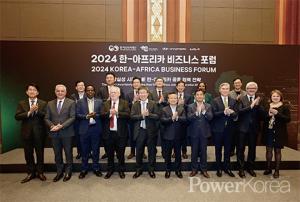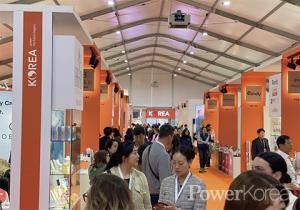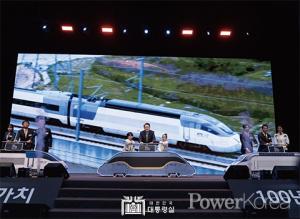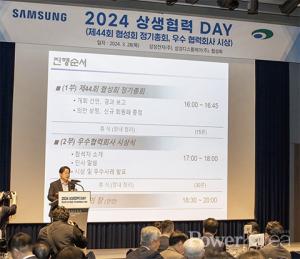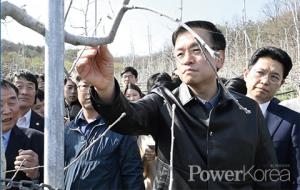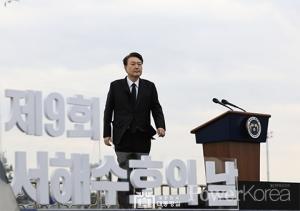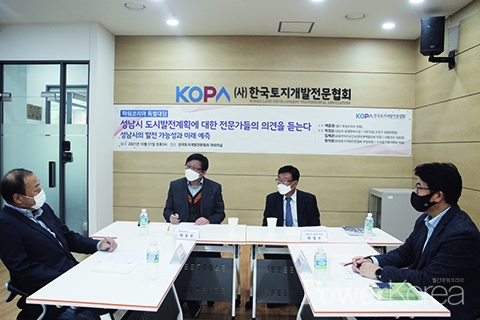 |
||
| ▲ Land Owners and Residents Solidarity for Public Housing Development | ||
PowerKorea hears from persons concerned
[Panels]
Jongwon Baek, Publisher of PowerKorea
Jeongoh Park, Former Deputy Mayor of Seongnam City
Chaegwan Im, President of Land Owners and Residents Solidarity for Public Housing Development
Sukwon Heon, CEO of Seoul Architect E&C and Vice President of Korea Land Development Professional Association
[Problems]
Baek:
What do you think are the problems regarding housing and urban development in the city?
Park:
The city consists of the old town, 3 new towns and a number of developing sites. The original downtown has been fall behind of the new ones which means that it needed a fast remodeling. Bundang in particular has been 30 years old which also needs remodeling while Pangyo and Wirye are well known new towns that seem to have settled down. The problem is that the city is suffering from the gap between the rich and the poor as a result of these developments. In other words, residents in and round the old town have been feeling disadvantaged.
Heon:
In fact, the old town has been designated for remodeling and some parts are already under process. But it is important for the city to make sure that the benefits should go fairly and connecting the old town with the new towns is especially important.
Im:
I want to point out that the public housing projects run by the LH (Korea Land & Housing Corporation) have compensated native residents far less than they deserved. The projects must serve for citizens by hearing their needs and wants rather than used as a means to make money by some people in the advantageous positions.
[Bundang]
Baek:
Budang is the 30 year old first phase new town and talks on remodeling have been ongoing. What are your opinions?
Heon:
It is highly possible that this area would decide how other new towns are remodeled in the future. In other words, the remodeling plan of Bundang will be used as a reference of other new towns. Citizens in the area are considering both possibilities of rebuilding and remodeling and some zones are already under remodeling.
Park:
Bundang also is the traffic hub of the in and around areas so whether rebuilding or remodeling the efficient traffic flow must be well planned out.
Im:
Bundang certainly will see increasing demand for rebuilding and remodeling and the benefits must go evenly to residents. It is a good idea that some parts of the area are used as roads to ease down the traffic issues around the areas.
Park:
Before that, it is important to gather opinions of the residents in the area and also citizens as a whole. Connecting the old town with new towns and surrounding areas will play positive for the city to grow as a traffic hub of the capital region.
[Worries and Complaints]
Baek:
Apart from housing and traffic, what do you think should be done in order to make a better city?
Park:
The greener the city becomes the better. But it is important to keep the balance between green areas and residential and commercial areas.
Im:
I’m worried about over development on the mountain areas around the city. This actually is contributing to traffic jams and citizens are the one who are suffering from this. So the city needs to bring up rational redevelopment plans.
Heon:
Seongnam faces Seoul, Gwacheon, Uiwang, Yongin, Gwangju and Hanam. The roads to Gwangju and Yongin are especially jammed which needs to be improved. The city states public development of green areas on its 2035 Seongnam Urban Development Plan and it is very important to run the supervisory agency in order to avoid the recent land development gate in the city.
Im:
The Daejang-dong Gate is such a fuss nationwide and we actually visited the area to hear how native residents in the area feel. It is an utter regret that the project involves malpractice while native residents are obliviously exempted from the benefit.
Park:
Again, keeping the balance between green areas and exercising property rights is very important. The government lifted the ban of development of green areas which actually belonged privately but that does not mean the owners can development their lands freely as it involves people in the surrounding areas. If development should be made, the benefits should also be shared with residents in the area. After all, we live together.
Im:
What worries me greatly is the government’s practice of expropriating private lands without preliminary agreements of land owners. In other words, land owners receive way too cheap the compensation and it is often the case that some of them do not know where to go after losing their lands. Where does the development benefit go then? I guess it will go a few developers who possibly have connections with political powers. It is exactly the case of the Daejang-dong Gate after we heard the residents in the area.
Heon:
A development almost always generates profits. The LH, for example, run development projects based on the Special Act on Public Housing. The problem is that the Act does not force where and how the generated development profits should be used. In other words, the LH sweeps most of the profits but no public institutions can check this. A report of the Citizen’s Coalition for Economic Justice shows that the public developers swept more than 6 trillion won ($5.1 billion) development profits in Pangyo development alone. This I think is only the tip of the iceberg and not many know where the profits have been used. And this practice is no different when the developer involves local governments which buy the land as cheap as possible and sweep most profits out of it. Therefore, where and how the profits are used must be transparent and open.
[Green City]
Baek:
I heard there are issues on dumpsites, sewage plants and power plants.
Park:
We all know we need a dumpsite in the city. The problem is that it must not be built in their areas. So the ideal solution seems to build an eco-friendly dumpsite since the related technologies are available. If it is still not impossible, we should find a way to bury it underground on a carefully planned urban design.
Heon:
Many incinerators are operating eco-friendly thanks to cutting edge techs. Also, the power generated during the process is being used for renewable energy such as to heat up the water. So the city needs to use this wisely.
Im:
It is important for the city to take this into consideration when building dumpsites and sewage and power plants as we are ready to provide necessary support on this. This way, the city and the citizens can work together to create a green city.
[Tech Hub]
Baek:
Nestled in the city are top IT companies and promising ventures. What are your prospects on this?
Park:
Pangyo Techno Valley is very famous and two more of similar valleys are expected to come. For now, the city should make most of Techno Valley, Yatap Valley and High Tech Valley to keep the reputation rolling.
Im:
Again, I think it is important for the city to keep the balance between old and new towns when creating IT hubs so that as many citizens as possible can benefit from the development.
Heon:
IT side apart, I think the city lacks entertainment zones and facilities. The city should promote cultural industries and tourism so that they can create synergy for regional economy.
[Daejang-dong Gate]
Baek:
Daejang-dong Gate has left a stain on city’s reputation. How can we prevent this from happening again?
Park:
The Daejang-dong development was managed by the Seongnam Urban Development Corporation, and the city issued the licenses of the business. So the documents must be kept somewhere in the two offices. Both parties, therefore, must open the record transparently to the citizens as well as to the people to prevent this from happening again.
Im:
I can easily imagine the citizens’ disappointment and a feeling of deprivation. What they received was crumbs of the bread while only a few developers had a feast on most of the bread. Like Park said, all procedures and processes of public housing development must thoroughly and transparently be open to the public to prevent similar gates from happening again.
Heon:
The central government must make clear of the lines between public ownership of the land and the private ownership of the land. Expropriation of the government then must be made based on this and open to the public transparently from the beginning to the end.
Park:
Transparency, fair share of profits and balanced development I think are the three keywords of the city. Through this, the city will find back the former reputation of excellent new towns. (PowerKorea)
Baek:
Well, thanks for your valuable opinions. I hope Seongnam City will reborn as a clean, green, fair and transparent city.
PowerKorea is an official partner of Herald Corporation. The magazine is distributed to the KOTRA business centers in the world. PowerKorea publishes latest news of government, Samsung, Hyundai and LG and endeavors to serve a platform to engage with people around the world.
백종원 기자 bridgekorea@naver.com

